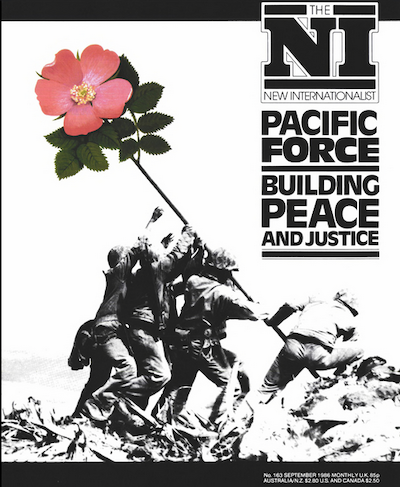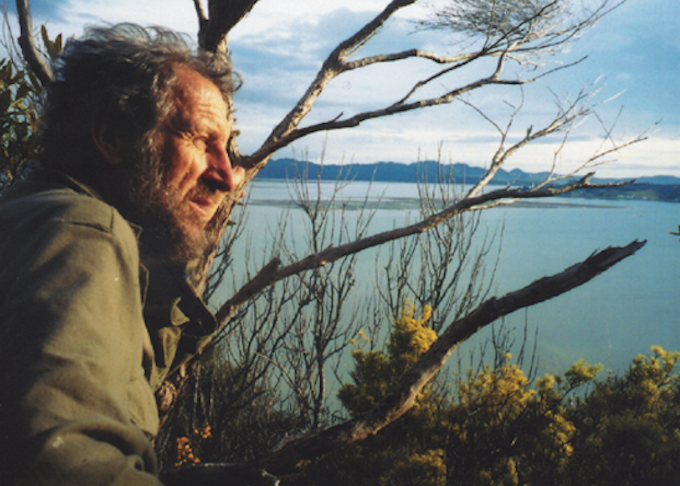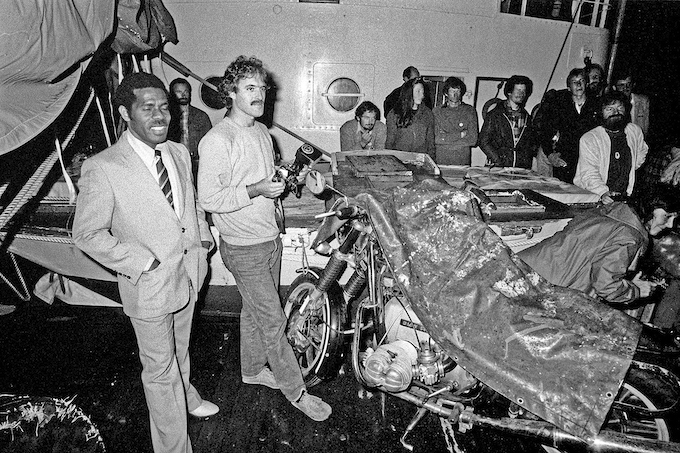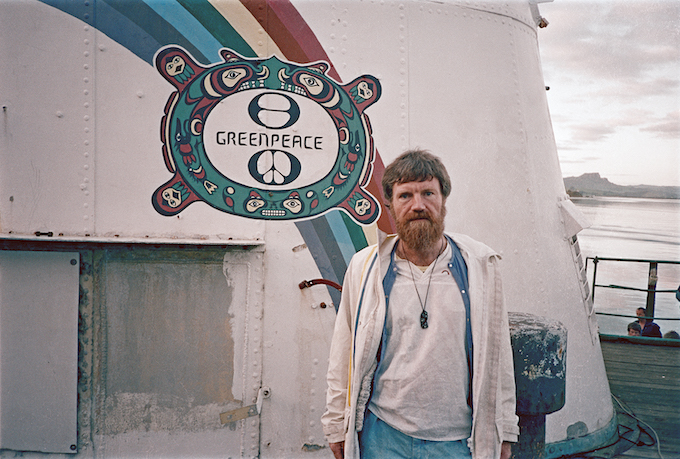When Aotearoa (NZ) banned nuclear warships from its ports it was seen as David standing up to Washington’s Goliath. But behind Prime Minister David Lange is a whole army of peace campaigners forcing him to sling his shot. David Robie traces the history of their resistance — and shows how ordinary people declaring their home as a nuclear-free-zone helped send a message to the superpowers.

By David Robie
Artist Debra Bustin sat dejectedly among the Reagan and Muldoon masks, papier mâché missiles and effigies of babies on stakes, waiting. The Nuclear Horror Show, a dramatic piece of street theatre, was ready to roll — but there was no transport. The truck supposed to have carted the props to the start of the demonstration in the heart of the capital, Wellington, had failed to turn up.
But another peace campaigner had an idea. He darted out onto the nearby street and stopped the first empty truck.
‘Hey mate, we’ve got to get all this stuff to the big anti-nuclear rally across town,’ he said. ‘Can you help us?’
Ten years before, the truck driver would have laughed at the campaigner’s cheek. But this was September 1983, and the peace and anti-nuclear groups in Aotearoa (NZ) had become a mass movement. The driver was delighted to help and the macabre show went ahead.
Within ten months, conservative Prime Minister Sir Robert Muldoon had been swept out of office as David Lange and the Labour Party were catapulted into power on a nuclear-free Aotearoa platform which stunned the country’s Western allies, particularly the US. And the new government swiftly announced it intended to ban nuclear-armed and nuclear-powered ships from the country’s ports.
Internationally, the move was perceived to be a bold, idealistic new step by a reformist government. Critics tried to suggest it was the result of some Machiavellian plot by the party’s militant left wing. In fact, it was the culmination of a policy which had first been introduced more than a decade earlier and had been reinforced at grassroots level by a highly motivated peace movement.
Indeed, even if the government itself had had doubts about the policy, it would have had little choice. Opinion polls showed 74 percent of people in favour of banning nuclear-armed ships, two thirds of the country’s 3.2 million population lived in self-proclaimed ‘nuclear-free zones’ and four out of five competing parties (including a new breakaway right-wing group) had the policy as part of their platforms. So what created this revolution in public opinion, and is there a lesson that the global peace movement can learn from Aotearoa’s example?
The peace movement in Aotearoa itself had humble beginnings in the 1960s with the Campaign for Nuclear Disarmament (CND)’s local Easter rallies being miniature clones of the huge annual Aldermaston march in the UK. But in 1968, two things combined to create the first major rallying point The first was the screening of Peter Watkins’ anti-nuclear TV film The War Game (which was banned in the UK). The second was the US Navy’s plan to build a radio communications base called Omega, which was to aid the navigation of Polaris submarines. Sensitised to the issue by the documentary. Aotearoans were so outraged by the Omega plan that it had to be shelved.
‘Government Deals NZ into War Game,’ said one newspaper.
‘The Watkins film brought home to Aotearoans the possibility of the country being a nuclear target,’ says peace researcher Owen Wilkes. ‘Until then war had been a kind of sporting event. It was something that happened on the other side of the world.’
Anti-nuclear feeling contributed to Labour’s election victory under Norman Kirk in 1972. Their nuclear-free policy emerged from the fallout shelter hysteria of the early 1960s, thermonuclear tests by the superpowers and the escalating Vietnam war. In the three heady years which followed, the Kirk government shut out nuclear-armed and powered ships from Aotearoa’s ports. They also despatched frigates in support of the vulnerable flotillas of yachts which sailed to Moruroa in protest at French nuclear testing there.
But then the nuclear-free strategy was dealt a body blow. The National Party was re-elected in 1975 and Muldoon ushered in his decade of power by welcoming back nuclear ships. The Peace Squadron was formed in response — a loose coalition of people whose yachts, small boats and other craft mounted spectacular waterborne protests against visiting nuclear ships.
Another focus for the peace movement was the creation of nuclear-free zones. ‘We campaigned to declare your house, dog, car and boat nuclear-free,’ recalls Maire Leadbeater, leader of CND. It seemed small fry at the time, but later it was realised what a clever strategy it had been. It gave peace activists a manageable goal while at the same time making elected councils take a stand against nuclear facilities visiting or being sited in their area.
Canadian émigré Larry Ross dived into the nuclear issue in 1979 with a crusader’s zeal and an ‘ad man’s flair’. He made his Christchurch home headquarters of the New Zealand Nuclear Free Zone Committee and sparked off a movement which had remarkable success: 66 percent of the population now live in such zones declared by local authorities.
One after another local authorities declared themselves nuclear-free in the face of a barrage of letter-writing and lobbying by peace campaigners. Even larger cities became nuclear-free — councillors in the country’s largest city of Auckland considered the issue three times before deciding yes. Indeed, it was better, according to Larry Ross, for a council to refuse the demand at first – because this meant campaigners had to go out and involve local people, talk to them on the doorstep and get them to sign petitions.
By the 1980s the movement was becoming more organised. Peace Movement Aotearoa was formed, while Māori campaigners, seeking with increasing success to link anti-nuclearism with racism and land rights, set up the Pacific People’s Anti-Nuclear Action Committee.
In the wake of the social upheaval caused by the protests against apartheid during the 1981 South African rugby tour, enormous energy was released which became diverted to the peace movement. In one week alone, 40,000 people protested against a warship visit. The peace movement was finally a mass one — and the Lange Government’s policy was a direct result.

‘Everybody thinks we have this brilliant Labour government which is dedicated to pacifism,’ says Owen Wilkes. ‘But it isn’t, the government simply responded to public opinion whereas in other countries where there have been similar high percentages against nuclear weapons, governments haven’t reacted.’
Why has there been such an extraordinary level of popular backing for the policy in Aotearoa, a country which is so far from the centres of the world tension and so unlikely to be a target in the case of any nuclear attack? One key factor has been the bitter resentment most people feel towards French nuclear testing in the South Pacific.
French persistence with the tests in arrogant disregard of repeated protests by Aotearoa, Australia and other neighbouring Pacific nations has helped keep Aotearoans acutely aware of the nuclear issue. It has also helped to provide the peace movement with credibility.

Last year [1985], the sight of the Greenpeace ship Rainbow Warrior, lying bombed and submerged in Auckland harbour while crew members mourned their dead photographer colleague, Fernando Pereira, became a brutal reminder to all Aotearoans of the realities of raising a voice against war. And it unquestionably strengthened the Lange government’s anti-nuclear resolve.
While Lange is portrayed internationally as a champion of the nuclear-free strategy, he is at times accused at home of back-pedalling on the issue. The peace movement is also watchful for any sign that the government might soften its stance.
Last year [1985] the government tried to allow the nuclear-capable American warship Buchanan to visit and was only stymied by the strength of the peace movement. The protest ruined a carefully laid plan by the bureaucracy to open up a chink in the antinuclear strategy and prepare the ground for a compromise with the US.
Aotearoa’s policy has pushed it into an increasingly isolated position within the Western alliance. The US has applied severe pressure on the Lange government both overtly through diplomatic harassment and covertly through attempts to influence Aotearoans by CIA-funded projects involving journalists, trade unionists and other opinion leaders. Britain, meanwhile, has sent envoys like Baroness Young to warn that if the New Zealand Nuclear-Free Zone, Disarmament and Arms Control Bill were passed by Parliament it would mean Aotearoa and the rest of the Western alliance would move apart.
In the face of this international pressure, Lange has become increasingly cautious. At Oxford University during the popular debate with the American Moral Majority’s Jerry Falwell in March 1985, Lange delighted in his image as the nuclear-free David challenging the superpower Goliath.
But barely 15 months later his delight in the image was not so obvious. On his first major tour of European capitals, in the wake of Chernobyl, he was determined to reassure Western leaders that he was no pawn of the peace movement. During a speech to the Nobel Peace Prize-winning International Physicians for the Prevention of Nuclear War he almost appeared to be defending the nuclear powers in his anxiety not to be seen to be ‘exporting’ the anti-nuclear policy.
Many people in the peace movement were disappointed that he did not use the occasion to make an emotional plea to the West to follow Aotearoa” example. They know that they have to keep up the pressure so as to counteract the influence of the Western alliance — and support from people internationally will help them. Otherwise a stand that has become a great source of hope to the worldwide peace movement might be endangered.
David Robie is a journalist based in Auckland. He specialises in Pacific affairs and is the author of Eyes of Fire (see box below).

World headlines
The sabotage of the Rainbow Warrior by the French Secret Service made world headlines. But few of those stories told us that the boat had just arrived back from a mercy mission — evacuating the Pacific islanders of Rongelap from their home atoll in the Marshall Islands, still drenched by radiation from a US nuclear test in 1954. The bomb dropped then, codenamed ‘Bravo’, was over a thousand times more powerful than the one dropped on Hiroshima, and the islanders have always claimed that the US deliberately used them as guinea pigs. These quotations tell one of the most iniquitous stories of the nuclear age:
‘In a sense the Marshall Islanders are the first victims of the Third World War. They are the first culture in the history of our race which ahs been effectively destroyed by radiation.’ — Denis O’Rourke, director of the acclaimed film about the Marshall Islanders, Half Life.
‘We heard a noise like thunder. We saw some strange clouds over the horizon. But the sun in the west faded away. In the afternoon something began falling from the sky upon our island. It looked like ash from a fire. It fell on me, it fell on my wife, it fell on our infant son. It fell on the trees, and on the roofs of our houses. It fell on the reef and into the lagoon.
‘We were very cautious about this ash falling from the sky. Some people put it in their mouths and tasted it. One man rubbed it into his eyes to see if it would cure an old ailment. People walked in it, and children played in it.’ — John Anjain, mayor of Rongelap when the explosion took place on 1 March 1954. In 1972 his son Lekoj died of leukaemia blamed on the fall out.
‘Greater knowledge of (radiation) effects on human beings is badly needed. Even though the radioactive contamination of Rongelap Island is considered perfectly safe for human habitation, the levels of activity are higher than those found in other inhabited locations in the world. The habitation of these people on the island will afford the most valuable ecological radiation data on human beings.’
— Brookhaven National Laboratory in New York, Medical Survey March 1957.
‘The Rongelapese have for years accused US government scientists of using them as guinea pigs. They claim that their exposure to Bravo was not an accident but part of an experiment to test the effects of radiation on human beings. The US Government has consistently claimed that the fallout was ‘accidental’ and caused by ‘an unprecedented shift in the winds’. However, in 1984, a declassified Defence Nuclear Agency report surfaced confirming that the fallout was in fact not an accident. The report said that, six hours before the blast, weather briefings showed winds at 20,000 feet were heading for Rongelap.’ — David Robie, author of Eyes of Fire.
‘The wind had been blowing straight at us for days before the test. It was blowing straight at us during the test, and straight at us after it. The wind never shifted.’ — Gene Curbow, senior weather technician on the neighbouring atoll of Rongerik, who took radio-sound weather measurements up to an altitude of 30,000 meters before and after Bravo. Curbow and US veterans stationed there have suffered since from a variety of illnesses including cancer, tumours, heart and thyroid conditions, and urinary and bladder disorders that they say were related to Bravo. Three of them said they had difficulty in fathering children or had had sickly offspring.
‘When we decided to leave Rongelap Atoll, the old people cried to leave their homeland. But I said, “What about your grandchildren? Do you want them to die?”‘ — Jeton Anjain, a Marshall Islands Senator.
All material from Eyes of Fire; the last voyage of the Rainbow Warrior by David Robie (Lindon – NZ 1986; Ravette – UK, 1986; New Society Publishers – USA, 1987; Asia Pacific Network, 2005; Little Island Press, 2015).
Aotearoa’s own peace needs
Aotearoa is now seen as a peacemaker on the world stage. But Māori and Pacific Islanders see little sign that their own needs for peace and social justice are being taken seriously and they ‘denounce any actions of the present state of Aotearoa, which acts at a mini-superpower in the Pacific’. Hilda Halkyard-Harawira puts their case:
“The Māori people are the indigenous people of Aotearoa — the land known to the international community as New Zealand. We are also children of the Great Ocean of Kiwa (Pacific), and we trace our ancestry back to the lands of Hawai’i and Tahiti Nui.
“The indigenous peoples of the Pacific are small nations, and often our plight goes unheard. And yet, isolated though we are geographically, our histories of colonisation match almost exactly those of our indigenous brothers and sisters throughout the world.
“We too have been forced to carry our cultures within our hearts and wear the culture of the European like a second skin. And today we too are but second-class citizens in our own homelands. Today we suffer the classic effects of colonisation endemic drug and alcohol problems, high mortality and suicide rates, apathy, self-hatred and identity crises. And now, as if that were not enough to cope with, an even greater and more deadly monster looms — nuclear death. The superpowers have invested in a new war game. The Pacific is the battlefield. Pacific peoples are the pawns. Even those not directly involved in the making of nuclear war will kill, so also will we be decimated by the dumping of radioactive waste in our oceans.
“We are denied the information that will help us to build our movement. The truth is always hidden from us, and we are made to feel powerless and ineffective.
“But despite all this, the spirit of resistance is strong. We have withstood the erosion of our culture and we continue to yearn for the freedom and peace that was once our birthright. And if all we can do in our lifetime is guarantee our children’s survival in a Nuclear Free and Independent Pacific, then we will have achieved something.”
Hilda Halkyard-Harawira lives in Aotearoa New Zealand, and is the Australasian representative for the Nuclear-Free and Independent Pacific Movement.

